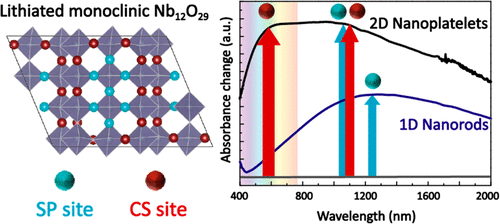当前位置:
X-MOL 学术
›
J. Am. Chem. Soc.
›
论文详情
Our official English website, www.x-mol.net, welcomes your feedback! (Note: you will need to create a separate account there.)
Controlling the Shape Anisotropy of Monoclinic Nb12O29 Nanocrystals Enables Tunable Electrochromic Spectral Range
Journal of the American Chemical Society ( IF 15.0 ) Pub Date : 2021-09-14 , DOI: 10.1021/jacs.1c06901 Hsin-Che Lu 1 , Naman Katyal 2 , Graeme Henkelman 2 , Delia J Milliron 1
Journal of the American Chemical Society ( IF 15.0 ) Pub Date : 2021-09-14 , DOI: 10.1021/jacs.1c06901 Hsin-Che Lu 1 , Naman Katyal 2 , Graeme Henkelman 2 , Delia J Milliron 1
Affiliation

|
Electrochromic smart windows that modulate the solar transmittance in a wide and selective spectral range can optimize building energy efficiency. However, for conventional materials such as bulk transition metal oxides, the electrochromic spectral range is constrained by their crystal structure with limited tunability. Herein, we report a method to control the shape anisotropy of monoclinic Nb12O29 nanocrystals and obtain a tunable electrochromic spectral range. We demonstrate the synthesis of monoclinic Nb12O29 nanorods (NRs), extending one-dimensionally along the b direction, and monoclinic Nb12O29 nanoplatelets (NPLs), extending two-dimensionally along the b and c directions. Upon electrochemical reduction accompanied by Li insertion, the NR films show increasing absorbance mostly in the near infrared region. In contrast, the NPL films show increasing absorbance in the near infrared region first followed by increasing absorbance in both visible and near infrared regions. To elucidate the influence of shape anisotropy, we used density functional theory to construct the lithiated structures of monoclinic Nb12O29 and in these structures we identified the presence of square planar sites and crystallographic shear sites for Li insertion. By calculating the theoretical spectra of the lithiated structures, we demonstrate that the Li insertion into the square planar sites results in absorption in the near infrared region in both NRs and NPLs due to their extension in the b direction, while the subsequent insertion of Li into the crystallographic shear sites leads to absorption in both visible and near infrared regions, which only occurs in NPLs due to their extension in the c direction.
中文翻译:

控制单斜 Nb12O29 纳米晶体的形状各向异性实现可调谐电致变色光谱范围
电致变色智能窗户可在宽广的选择性光谱范围内调节太阳光透射率,从而优化建筑能源效率。然而,对于常规材料,如块状过渡金属氧化物,电致变色光谱范围受其晶体结构的限制,可调性有限。在此,我们报告了一种控制单斜 Nb 12 O 29纳米晶体形状各向异性并获得可调电致变色光谱范围的方法。我们展示了沿 b 方向一维延伸的单斜 Nb 12 O 29纳米棒 (NRs) 和单斜 Nb 12 O 29的合成纳米血小板 (NPL),沿 b 和 c 方向二维延伸。在伴随锂插入的电化学还原时,NR 薄膜显示出主要在近红外区域的吸光度增加。相比之下,NPL 薄膜首先在近红外区域显示出吸光度增加,然后在可见光和近红外区域吸光度增加。为了阐明形状各向异性的影响,我们使用密度泛函理论构建了单斜晶 Nb 12 O 29的锂化结构在这些结构中,我们确定了锂插入的方形平面位点和晶体剪切位点的存在。通过计算锂化结构的理论光谱,我们证明了锂插入方形平面位点会导致 NRs 和 NPLs 的近红外区域吸收,因为它们在 b 方向上延伸,而随后的锂插入到晶体剪切位点导致可见光和近红外区域的吸收,这仅发生在 NPL 中,因为它们在 c 方向上延伸。
更新日期:2021-09-29
中文翻译:

控制单斜 Nb12O29 纳米晶体的形状各向异性实现可调谐电致变色光谱范围
电致变色智能窗户可在宽广的选择性光谱范围内调节太阳光透射率,从而优化建筑能源效率。然而,对于常规材料,如块状过渡金属氧化物,电致变色光谱范围受其晶体结构的限制,可调性有限。在此,我们报告了一种控制单斜 Nb 12 O 29纳米晶体形状各向异性并获得可调电致变色光谱范围的方法。我们展示了沿 b 方向一维延伸的单斜 Nb 12 O 29纳米棒 (NRs) 和单斜 Nb 12 O 29的合成纳米血小板 (NPL),沿 b 和 c 方向二维延伸。在伴随锂插入的电化学还原时,NR 薄膜显示出主要在近红外区域的吸光度增加。相比之下,NPL 薄膜首先在近红外区域显示出吸光度增加,然后在可见光和近红外区域吸光度增加。为了阐明形状各向异性的影响,我们使用密度泛函理论构建了单斜晶 Nb 12 O 29的锂化结构在这些结构中,我们确定了锂插入的方形平面位点和晶体剪切位点的存在。通过计算锂化结构的理论光谱,我们证明了锂插入方形平面位点会导致 NRs 和 NPLs 的近红外区域吸收,因为它们在 b 方向上延伸,而随后的锂插入到晶体剪切位点导致可见光和近红外区域的吸收,这仅发生在 NPL 中,因为它们在 c 方向上延伸。


























 京公网安备 11010802027423号
京公网安备 11010802027423号